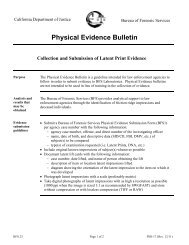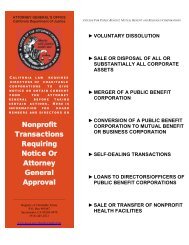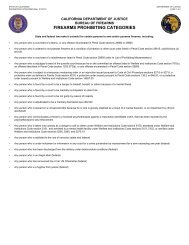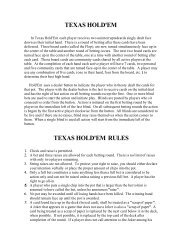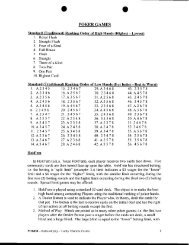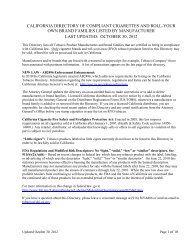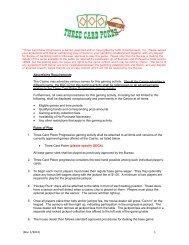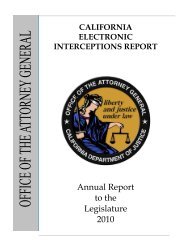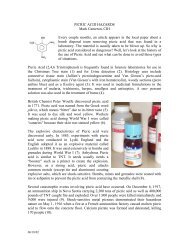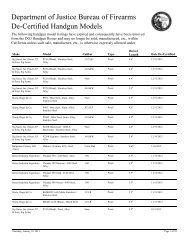Physical Evidence Bulletin-Collection of Evidence in Sexual Assault ...
Physical Evidence Bulletin-Collection of Evidence in Sexual Assault ...
Physical Evidence Bulletin-Collection of Evidence in Sexual Assault ...
You also want an ePaper? Increase the reach of your titles
YUMPU automatically turns print PDFs into web optimized ePapers that Google loves.
California Department <strong>of</strong> Justice<br />
<strong>Physical</strong> <strong>Evidence</strong> <strong>Bullet<strong>in</strong></strong><br />
<strong>Collection</strong> <strong>of</strong> <strong>Evidence</strong> <strong>in</strong> <strong>Sexual</strong> <strong>Assault</strong> Investigations<br />
Purpose The <strong>Physical</strong> <strong>Evidence</strong> <strong>Bullet<strong>in</strong></strong> is a guidel<strong>in</strong>e <strong>in</strong>tended for law enforcement agencies to<br />
follow <strong>in</strong> order to submit evidence to BFS Laboratories. <strong>Physical</strong> <strong>Evidence</strong> bullet<strong>in</strong>s<br />
are not <strong>in</strong>tended to be used <strong>in</strong> lieu <strong>of</strong> tra<strong>in</strong><strong>in</strong>g <strong>in</strong> the collection <strong>of</strong> evidence.<br />
Analysis and<br />
results that<br />
may be<br />
obta<strong>in</strong>ed<br />
M<strong>in</strong>imum<br />
evidence<br />
required<br />
Bureau <strong>of</strong> Forensic Services<br />
The Bureau <strong>of</strong> Forensic Services (BFS) provides analytical support to law enforcement<br />
agencies through the identification <strong>of</strong> physical evidence <strong>in</strong> sexual assault cases.<br />
<strong>Physical</strong> evidence <strong>in</strong> sexual assault cases can assist <strong>in</strong> establish<strong>in</strong>g elements <strong>of</strong> the<br />
crime, help to identify or elim<strong>in</strong>ate a suspect, and can be used to corroborate or dispute<br />
statements. The evidence most <strong>of</strong>ten encountered <strong>in</strong> sexual assault cases <strong>in</strong>cludes not<br />
only biological evidence (e.g., semen) but also f<strong>in</strong>gerpr<strong>in</strong>ts, impression evidence (e.g.,<br />
shoepr<strong>in</strong>ts), and trace evidence (e.g., hairs/fibers).<br />
Goals <strong>of</strong> Biological <strong>Evidence</strong> <strong>Collection</strong><br />
• Collect as much sample as possible from a s<strong>in</strong>gle source.<br />
• Keep biological evidence sta<strong>in</strong> concentrated.<br />
• Ensure that the sample is not <strong>in</strong>advertently mixed with other biological samples<br />
(e.g., contam<strong>in</strong>ated).<br />
• Wear gloves and change them on a regular basis or between items. Change<br />
gloves if they become sta<strong>in</strong>ed with any biological sample.<br />
• Do not talk over any biological evidence sample or consider wear<strong>in</strong>g a face mask.<br />
• Handle the sample <strong>in</strong> a manner, which m<strong>in</strong>imizes deterioration <strong>of</strong> the sample.<br />
• When deal<strong>in</strong>g with items for DNA analysis, do not touch your face, etc. with<br />
gloved hands. This can <strong>in</strong>advertently transfer your DNA to the items.<br />
• Air-dry the sample as fast as possible, preferably <strong>in</strong> a stream <strong>of</strong> cool air.<br />
Submit to the laboratory appropriate reference samples for all <strong>in</strong>dividuals <strong>in</strong>volved <strong>in</strong><br />
the case. This can <strong>in</strong>clude suspect, victim, and consensual partner references, as well as<br />
users <strong>of</strong> items swabbed for touch DNA. DNA database (CODIS) samples are not<br />
evidentiary and therefore not suitable for use as a reference sample <strong>in</strong> an evidentiary<br />
case. The DNA database is for <strong>in</strong>vestigative leads <strong>in</strong> cases <strong>of</strong> unknown suspects. Also<br />
submit appropriate evidence items or swabs, substrate controls, water blanks <strong>in</strong> the case<br />
<strong>of</strong> trace DNA (touch DNA) samples, and sexual assault evidence kits.<br />
BFS 23 Page 1 <strong>of</strong> 6 PEB 7 (Rev. 12/11)
<strong>Collection</strong>, General Crime Scene<br />
mark<strong>in</strong>g, and<br />
packag<strong>in</strong>g<br />
• Collect all items at the scene hav<strong>in</strong>g possible evidentiary value<br />
o Anyth<strong>in</strong>g which might have orig<strong>in</strong>ated from the suspect/victim (depend<strong>in</strong>g<br />
upon the nature <strong>of</strong> scene [e.g., victim's or suspect's residence])<br />
o Anyth<strong>in</strong>g that may provide <strong>in</strong>formation about what occurred.<br />
• Process the crime scene systematically for evidence:<br />
o Photos: To record the scene and identify items <strong>of</strong> evidence.<br />
o Sketches: To establish spatial relationships.<br />
o Latent Pr<strong>in</strong>ts: Best evidence for identification <strong>of</strong> the suspect(s) should<br />
always be considered. Focus on anyth<strong>in</strong>g that may have been handled or<br />
touched by assailant(s).<br />
o Shoepr<strong>in</strong>ts, Tire Tracks, Toolmarks: Impression evidence that may serve to<br />
l<strong>in</strong>k suspect(s) to a crime scene.<br />
o Biological <strong>Evidence</strong> - Biological evidence <strong>in</strong>cludes blood, hair, saliva,<br />
semen, other body fluid sta<strong>in</strong>s, and trace DNA. Any <strong>of</strong> this evidence may<br />
be important and should be collected. All sta<strong>in</strong>s collected should be<br />
accompanied by a control sample from an unsta<strong>in</strong>ed area near the collected<br />
sta<strong>in</strong>. A forensic light source (e.g., Polilight or Woods lamp) may be <strong>of</strong><br />
assistance <strong>in</strong> locat<strong>in</strong>g biological sta<strong>in</strong>s.<br />
o Bedd<strong>in</strong>g: Collect bedd<strong>in</strong>g upon which the assault occurred. If wet sta<strong>in</strong>s are<br />
located, <strong>in</strong>dicate their location with a piece <strong>of</strong> tape or circle with a<br />
waterpro<strong>of</strong> pen, allow to air dry, and then package by fold<strong>in</strong>g the edges<br />
toward the center and place <strong>in</strong> a paper bag.<br />
o Other <strong>Physical</strong> <strong>Evidence</strong>: Collect all other items at the scene hav<strong>in</strong>g<br />
possible evidentiary value. This <strong>in</strong>cludes anyth<strong>in</strong>g which might have<br />
orig<strong>in</strong>ated or been <strong>in</strong> contact with the assailant(s) or provide <strong>in</strong>formation<br />
about what occurred. Depend<strong>in</strong>g upon the type <strong>of</strong> scene be<strong>in</strong>g exam<strong>in</strong>ed<br />
(e.g., suspect's residence), collect any evidence possibly orig<strong>in</strong>at<strong>in</strong>g from<br />
the victim (e.g., cloth<strong>in</strong>g items). <strong>Evidence</strong> that could be useful <strong>in</strong> sexual<br />
assault <strong>in</strong>vestigations <strong>in</strong>cludes: fibers, hairs, saliva swabbed from a bite<br />
mark, lubricants or foreign objects used <strong>in</strong> the assault, or discarded cloth<strong>in</strong>g.<br />
Sta<strong>in</strong>s Found at Crime Scene<br />
• All biological evidence is subject to deterioration. The careful collection and<br />
storage <strong>of</strong> this evidence will help ensure that this evidence is preserved so that<br />
useful <strong>in</strong>formation can be obta<strong>in</strong>ed from its analysis.<br />
• The pattern <strong>of</strong> bloodsta<strong>in</strong> evidence may sometimes conta<strong>in</strong> important<br />
<strong>in</strong>formation. If the bloodsta<strong>in</strong> pattern is determ<strong>in</strong>ed to be important, it should be<br />
documented with appropriate sketches and photographs.<br />
• F<strong>in</strong>ally, biological evidence can conta<strong>in</strong> <strong>in</strong>fectious organisms (e.g., hepatitis<br />
virus) that can be transmitted to any person who contacts it. For these reasons, it<br />
is important to take proper safeguards to ensure the safety <strong>of</strong> all personnel.<br />
Recommendations for collect<strong>in</strong>g biological evidence sta<strong>in</strong>s:<br />
• Handle the evidence sta<strong>in</strong>s as little as possible. When possible, submit the item<br />
with the sta<strong>in</strong>. This is the easiest and best method to collect biological evidence.<br />
If the sta<strong>in</strong> is on a smooth, non-porous surface and can be easily dislodged,<br />
protect if from contact with other objects (e.g., immobilize <strong>in</strong> box).<br />
• If the sta<strong>in</strong> is on a large object with a porous surface (wood or carpet), the area<br />
with the sta<strong>in</strong> can be cut out and packaged <strong>in</strong> paper (e.g. paper bag or wrapped <strong>in</strong><br />
paper). Be sure to <strong>in</strong>clude a portion <strong>of</strong> the unsta<strong>in</strong>ed material as a control.<br />
BFS 23 Page 2 <strong>of</strong> 6 PEB 7 (Rev. 12/11)
• If it is not possible to collect the object or cut out the sta<strong>in</strong>, the sta<strong>in</strong> may be<br />
collected by us<strong>in</strong>g a slightly moistened (with distilled water) cotton swab. While<br />
collect<strong>in</strong>g the sta<strong>in</strong>, an effort should be made to concentrate it onto a small area<br />
on the swab. A substrate control sample <strong>of</strong> an unsta<strong>in</strong>ed area close to the<br />
biological evidence sta<strong>in</strong> should also be collected us<strong>in</strong>g the same distilled water<br />
and type <strong>of</strong> swab that was used to collect the evidence. Also submit a water<br />
blank swab <strong>of</strong> the water used for collection <strong>of</strong> the biological sta<strong>in</strong>s. Allow the<br />
swabs to air-dry, then package <strong>in</strong>dividually <strong>in</strong> appropriately marked paper<br />
envelopes or folded paper b<strong>in</strong>dles.<br />
• The size <strong>of</strong> the sta<strong>in</strong> should <strong>in</strong>fluence the size <strong>of</strong> a substrate used to collect the<br />
sta<strong>in</strong>. Thus, use a small part <strong>of</strong> a swab or a micro swab to collect a small sta<strong>in</strong>.<br />
Do not smear a small sta<strong>in</strong> over a large surface.<br />
Small biological evidence sta<strong>in</strong>s (e.g., 2 mm size bloodsta<strong>in</strong>) need special handl<strong>in</strong>g:<br />
• Put on a fresh pair <strong>of</strong> gloves before collect<strong>in</strong>g these samples.<br />
• Wear a face mask to avoid contam<strong>in</strong>at<strong>in</strong>g the sample with your own DNA.<br />
• If the entire item can be submitted to the laboratory, then it should be packaged<br />
and submitted to the laboratory. If the entire item cannot be submitted, then the<br />
sta<strong>in</strong>ed portion <strong>of</strong> the item can be cut out us<strong>in</strong>g a new or disposable tool and<br />
packaged for submittal to the laboratory. If the sta<strong>in</strong>ed portion cannot be cut out,<br />
then a sterile swab is probably the best sample collection device.<br />
Trace (touch) DNA samples need special handl<strong>in</strong>g:<br />
• Trace DNA is material that can be deposited by touch<strong>in</strong>g or handl<strong>in</strong>g and item;<br />
however, just handl<strong>in</strong>g an item does not mean that trace DNA will be found.<br />
• Trace DNA is a cumulative material. Subsequent handl<strong>in</strong>g <strong>of</strong> an item does not<br />
elim<strong>in</strong>ate previous DNA that is already there. In most cases, trace DNA results<br />
<strong>in</strong> complex mixtures <strong>of</strong> DNA. Also, trace DNA has no context. There is no way<br />
to tell when the DNA has been deposited or how it was deposited.<br />
• Put on a fresh pair <strong>of</strong> gloves before collect<strong>in</strong>g these samples.<br />
• Wear a face mask to avoid contam<strong>in</strong>at<strong>in</strong>g the sample with your own DNA.<br />
• If the entire item can’t be packaged for submittal to the laboratory, then a sterile<br />
swab is probably the best sample collection device. Lightly moisten 2 sterile<br />
swabs with distilled or sterile water and hold them together while thoroughly<br />
swabb<strong>in</strong>g the surface.<br />
• Submit a water blank swab (a swab moistened with the same water source used<br />
for the sample) for a control <strong>in</strong> cases <strong>of</strong> trace DNA.<br />
Try to m<strong>in</strong>imize the amount <strong>of</strong> time a sta<strong>in</strong> is kept wet. Air-dry all wet sta<strong>in</strong>s as<br />
soon as possible. Do not expose to heat or sunlight <strong>in</strong> an attempt to dry the sta<strong>in</strong>.<br />
In cases <strong>of</strong> fetal tissue, contact the laboratory for packag<strong>in</strong>g and submittal requirements.<br />
Do not use any preservatives and place the fetal tissue <strong>in</strong> a clean conta<strong>in</strong>er.<br />
Medical Personnel<br />
• Victim - Refer to the California Medical Protocol for Exam<strong>in</strong>ation <strong>of</strong> Adult<br />
<strong>Sexual</strong> <strong>Assault</strong> Victims and Child <strong>Sexual</strong> Abuse Victims for evidence collection<br />
guidel<strong>in</strong>es.<br />
• Ensure that all cloth<strong>in</strong>g worn dur<strong>in</strong>g or immediately after the assault is collected.<br />
Package <strong>in</strong> separate paper bags.<br />
BFS 23 Page 3 <strong>of</strong> 6 PEB 7 (Rev. 12/11)
Medical and/or Law Enforcement Personnel<br />
• Suspect - use a Suspect <strong>Sexual</strong> <strong>Assault</strong> <strong>Evidence</strong> Kit to collect relevant evidence<br />
and follow kit <strong>in</strong>structions:<br />
o All Cloth<strong>in</strong>g Worn By Suspect at the time <strong>of</strong> assault: Package separately <strong>in</strong><br />
paper bags (not plastic).<br />
o Pubic Hair Brush<strong>in</strong>g: Place a paper towel or piece <strong>of</strong> paper under the area<br />
be<strong>in</strong>g brushed. Brush the pubic region. Wrap the brush <strong>in</strong> the piece <strong>of</strong><br />
paper and place <strong>in</strong>to a paper envelope. Always collect pubic hair brush<strong>in</strong>g<br />
before collect<strong>in</strong>g pubic hair reference standards.<br />
o Pubic Hair Reference Standards: Pull or cut close to the sk<strong>in</strong> a m<strong>in</strong>imum <strong>of</strong><br />
20-30 hairs from different areas.<br />
o Head Hair Reference Standards: Pull or cut close to the sk<strong>in</strong> approximately<br />
20-30 hairs taken from several areas to <strong>in</strong>clude front, back, sides, and top.<br />
o Other Body Hairs: Take additional hair samples if case <strong>in</strong>dicates.<br />
o Reference Samples: Collect at least one blood sample, approximately 5cc,<br />
<strong>in</strong> a lavender-stoppered tube [conta<strong>in</strong><strong>in</strong>g EDTA]. The crime laboratory<br />
should be <strong>in</strong>formed if the subject had recently received a blood transfusion<br />
<strong>of</strong> any k<strong>in</strong>d. The tubes should be placed <strong>in</strong>to a labeled envelope.<br />
Alternatively, an oral (mouth) swabs (e.g., swabs <strong>of</strong> the <strong>in</strong>side <strong>of</strong> cheek) can<br />
be used as a reference sample. If oral samples are obta<strong>in</strong>ed, take 2 swabs<br />
and vigorously rotate the swab on the <strong>in</strong>side surface <strong>of</strong> the subject’s cheeks.<br />
It is imperative that these samples be dried as soon as possible. When the<br />
samples are dry, they may be placed <strong>in</strong>to a labeled paper envelope or bag.<br />
The evidence envelope/bag should be labeled and taped sealed.<br />
o Sample for Blood Alcohol or Drug Analysis - Collect this sample <strong>in</strong> a graystoppered<br />
tube [conta<strong>in</strong><strong>in</strong>g potassium oxalate/sodium fluoride].<br />
o Penile Swabs: If <strong>in</strong>dicated by the case history and time frame <strong>of</strong> case, penile<br />
swabs may be taken. Us<strong>in</strong>g swabs moistened with distilled water hold the<br />
swabs together as a unit and swab the glands, shaft, and base <strong>of</strong> the penis<br />
with a rotat<strong>in</strong>g motion to ensure uniform sampl<strong>in</strong>g. Air-dry swabs,<br />
package, label, and tape seal.<br />
o Scrotal Swabs: If <strong>in</strong>dicated by the case history (this evidence may be<br />
especially important if assailant wore a condom) scrotal swabs may be<br />
taken. Us<strong>in</strong>g swabs moistened with distilled water, hold the swabs together<br />
as a unit and swab the scrotum <strong>in</strong> a rotat<strong>in</strong>g motion, focus<strong>in</strong>g on area <strong>in</strong><br />
closest <strong>in</strong> proximity to penis. Air-dry swabs, package, label, and tape seal.<br />
o Extra Swabs - These swabs can be used to collect other semen, blood, or<br />
saliva sta<strong>in</strong>s on the sk<strong>in</strong>. Slightly moisten the swabs with distilled water<br />
and swab the suspected sta<strong>in</strong>. A substrate control swab should also be made<br />
by swabb<strong>in</strong>g an unsta<strong>in</strong>ed area adjacent to the sta<strong>in</strong>. Label the swabs<br />
<strong>in</strong>dicat<strong>in</strong>g the location from which it was taken. Air dry and package <strong>in</strong><br />
paper carton. If digital penetration is alleged, then swabs <strong>of</strong> the f<strong>in</strong>gers<br />
should be collected.<br />
o Miscellaneous – F<strong>in</strong>gernail cutt<strong>in</strong>gs can be collected. Us<strong>in</strong>g clean scissors<br />
or nail clippers, cut each nail as close to the quick as possible. Package the<br />
cutt<strong>in</strong>gs from each hand <strong>in</strong> separate paper b<strong>in</strong>dles and place <strong>in</strong>to the<br />
appropriate conta<strong>in</strong>ers. Alternatively, f<strong>in</strong>gernail debris can be collected<br />
us<strong>in</strong>g a toothpick to scrape each nail, or a swab for each nail. Place all five<br />
toothpicks or swabs from the right hand <strong>in</strong>to appropriate conta<strong>in</strong>er and<br />
label. Repeat for left hand. Collect any other foreign material, place <strong>in</strong><br />
paper b<strong>in</strong>dle, and package <strong>in</strong> envelope. Label and tape seal the envelope.<br />
BFS 23 Page 4 <strong>of</strong> 6 PEB 7 (Rev. 12/11)
Package all biological evidence <strong>in</strong> paper bags or envelopes. Do not use plastic:<br />
• Allow sta<strong>in</strong>s to air dry as much as possible before plac<strong>in</strong>g <strong>in</strong> paper bag or<br />
envelope.<br />
• Package the "unsta<strong>in</strong>ed control" separately from the evidence sta<strong>in</strong>.<br />
• Package different evidence items <strong>in</strong> separate paper conta<strong>in</strong>ers.<br />
• Ensure that paper conta<strong>in</strong>er is large enough to allow air circulation around<br />
evidence item.<br />
• Clean paper can be placed on (or <strong>in</strong>) a bloodsta<strong>in</strong>ed garment and the garment<br />
folded so that the paper prevents contact between different sta<strong>in</strong>s. Ensure that<br />
while items are dry<strong>in</strong>g that the sta<strong>in</strong> pattern(s) are not altered or the sta<strong>in</strong>(s) crosscontam<strong>in</strong>ated<br />
with other wet sta<strong>in</strong>(s).<br />
• Metal or glass evidence item (e.g., knife or broken, glass bottle), should be<br />
secured with wire to the bottom <strong>of</strong> a cardboard box so that it does not pierce the<br />
sides <strong>of</strong> a paper conta<strong>in</strong>er. If not secured, blood on a knife blade can become<br />
easily dislodged and lost. Do not freeze metal or glass evidence items with blood<br />
or other body fluid sta<strong>in</strong>s. Submit these items to the laboratory as soon as<br />
possible.<br />
• Condoms should be packaged <strong>in</strong> the follow<strong>in</strong>g manner:<br />
o If the condom is dry, it can be packaged <strong>in</strong> a paper bag or envelope.<br />
o If the condom is slightly moist, it can be packaged <strong>in</strong> a leak pro<strong>of</strong> conta<strong>in</strong>er<br />
(e.g., plastic jar).<br />
o If the condom conta<strong>in</strong>s significant liquid, try to absorb as much <strong>of</strong> the liquid<br />
on swabs. Dry the swabs and package them <strong>in</strong> a separate envelope.<br />
Package the condom <strong>in</strong> a leak pro<strong>of</strong> conta<strong>in</strong>er.<br />
• Tape seal, <strong>in</strong>itial, and date all packages.<br />
CAUTIONS Safeguards while handl<strong>in</strong>g biological evidence <strong>in</strong>clude:<br />
• Wear disposable (e.g., latex) gloves<br />
• Keep any contam<strong>in</strong>ated surface (e.g., gloved hand) away from face to prevent<br />
contact with mucosal membranes (e.g., eyes, nose).<br />
• After deal<strong>in</strong>g with evidence, properly dispose <strong>of</strong> gloves and wash hands with<br />
germicidal soap.<br />
Care should be taken to ensure that biological evidence is not contam<strong>in</strong>ated dur<strong>in</strong>g<br />
its collection:<br />
• Wear clean gloves and consider wear<strong>in</strong>g face masks. Change gloves between<br />
samples, especially if they become visibly sta<strong>in</strong>ed.<br />
• To avoid contam<strong>in</strong>ation, do not allow one evidence sta<strong>in</strong> to come <strong>in</strong>to contact<br />
with other biological samples.<br />
• M<strong>in</strong>imize contact with sample. Do not talk or cough over biological evidence.<br />
Do not handle samples without us<strong>in</strong>g clean gloves.<br />
• Each <strong>in</strong>dividual sta<strong>in</strong> should be collected separately. Do not collect or package<br />
two separate samples together.<br />
• Do not allow evidence samples to come <strong>in</strong>to contact with any surface that<br />
conta<strong>in</strong>s residue from another biological sample (e.g., dirty tweezers,<br />
bloodsta<strong>in</strong>ed glove, contam<strong>in</strong>ated work surface).<br />
• If tweezers must be used, use tweezers that have smooth, easy-to-clean work<strong>in</strong>g<br />
surfaces.<br />
• Reusable tools (e.g., tweezers, scissors) must be cleaned by thoroughly r<strong>in</strong>s<strong>in</strong>g<br />
BFS 23 Page 5 <strong>of</strong> 6 PEB 7 (Rev. 12/11)
The lab does<br />
not accept or<br />
process<br />
For further<br />
<strong>in</strong>formation<br />
and additional<br />
resources<br />
with a stream <strong>of</strong> fresh 10% bleach followed by a stream <strong>of</strong> distilled water. Wipe<br />
dry with a clean tissue.<br />
<strong>Evidence</strong> Storage<br />
• Submit appropriate items to the BFS laboratory <strong>in</strong> your area as soon as possible.<br />
If there is a large amount <strong>of</strong> evidence, call your local laboratory and discuss the<br />
case prior to submitt<strong>in</strong>g the evidence.<br />
• If the evidence cannot be immediately submitted to the laboratory:<br />
o Refrigerate liquid blood samples. Do not freeze.<br />
o Air-dry all items that conta<strong>in</strong> wet biological evidence. Do not subject to<br />
heat.<br />
o Until submission to the crime laboratory, freeze all items conta<strong>in</strong><strong>in</strong>g<br />
biological evidence except for any metal or glass items (e.g., knives or<br />
bottles). Metal or glass items should be stored at room temperature and<br />
submitted to the laboratory as soon as possible.<br />
• <strong>Evidence</strong> from the scene, suspect, and victim must be handled and packaged<br />
separately.<br />
The laboratory does not accept syr<strong>in</strong>ge needles. Contact the laboratory prior to<br />
submission if there is a need for such items to be analyzed.<br />
Please contact your regional BFS laboratory with any further questions that you may<br />
have.<br />
For a list <strong>of</strong> regional laboratories please go to:<br />
http://ag.ca.gov/bfs/pdf/bfs_brochure.pdf or http://ag.ca.gov/bfs/<br />
To locate the most current <strong>Physical</strong> <strong>Evidence</strong> <strong>Bullet<strong>in</strong></strong>s please go to:<br />
http://ag.ca.gov/cci/reference/reference.php#peb<br />
BFS 23 Page 6 <strong>of</strong> 6 PEB 7 (Rev. 12/11)





